Spatiotemporal Dynamics and Future Climate Change Response of Forest Carbon Sinks in an Ecologically Oriented County
Abstract
1. Introduction
2. Materials and Methods
2.1. Study Area
2.2. Data Sources and Processing
2.3. Methodology
2.3.1. Land Cover Classification
2.3.2. NDVI Spatiotemporal Fusion
2.3.3. NPP and NEP Estimation
2.3.4. Seasonal Mann–Kendall (MK) Test and Theil–Sen Slope Estimation
2.3.5. Standard Deviation Ellipse
2.3.6. PLUS Model
2.3.7. Multiple Linear Regression Prediction
3. Results
3.1. Factors of Forest NEP Simulation and Prediction
3.1.1. Land Cover Type Variation and Prediction
3.1.2. NDVI Variation and Prediction
3.1.3. Historical and Future Climate Variation
3.2. Spatiotemporal Variation in Forest NEP
3.2.1. Basic Characteristics of Forest NPP
3.2.2. Spatiotemporal Dynamics of Forest NEP
3.2.3. Historical Effects of Factors on Forest NEP
3.3. Prediction of Forest NEP Under 2035 Climate Scenarios
4. Discussion
4.1. Feasibility Verification
4.1.1. Land Cover Classification and Modeling
4.1.2. NDVI Fusion and Forecasting
4.1.3. NPP Simulated by the CASA Model
4.2. Spatiotemporal Dynamics of 2000–2023 Forest NEP
4.3. Prediction of Forest NEP Under 2035 Climate Scenarios
4.4. Prospects
5. Conclusions
Supplementary Materials
Author Contributions
Funding
Institutional Review Board Statement
Informed Consent Statement
Data Availability Statement
Acknowledgments
Conflicts of Interest
References
- Pan, Y.; Birdsey, R.A.; Fang, J.; Houghton, R.; Kauppi, P.E.; Kurz, W.A.; Phillips, O.L.; Shvidenko, A.; Lewis, S.L.; Canadell, J.G.; et al. A large and persistent carbon sink in the world’s forests. Science 2011, 333, 988–993. [Google Scholar] [CrossRef]
- Song, M.; Bae, J.S.; Seol, M.H. Development of the forest carbon sink index on afforestation and reforestation activities. J. Korean Soc. For. Sci. 2014, 103, 137–146. [Google Scholar] [CrossRef]
- Wang, Q.; Zheng, H.; Zhu, X.; Yu, G. Primary estimation of Chinese terrestrial carbon sequestration during 2001–2010. Sci. Bull. 2015, 60, 577–590. [Google Scholar] [CrossRef]
- Yu, G.; Chen, Z.; Piao, S.; Peng, C.; Ciais, P.; Wang, Q.; Li, X.; Zhu, X. High carbon dioxide uptake by subtropical forest ecosystems in the East Asian monsoon region. Proc. Natl. Acad. Sci. USA 2014, 111, 4910–4915. [Google Scholar] [CrossRef] [PubMed]
- Brown, S.; Lugo, A.E. Biomass of tropical forests: A new estimate based on forest volumes. Science 1984, 223, 1290–1293. [Google Scholar] [CrossRef]
- Malhi, Y.; Nobre, A.D.; Grace, J.; Kruijt, B.; Pereira, M.G.P.; Culf, A.; Scott, S. Carbon dioxide transfer over a Central Amazonian rain forest. J. Geophys. Res. Atmos. 1998, 103, 31593–31612. [Google Scholar] [CrossRef]
- Zhan, X.; Guo, M.; Zhang, T. Joint control of net primary productivity by climate and soil nitrogen in the forests of Eastern China. Forests 2018, 9, 322. [Google Scholar] [CrossRef]
- Ji, S.; Ren, S.; Fang, L.; Chen, J.; Wang, G.; Wang, Q. Improved CASA-Based Net Ecosystem Productivity Estimation in China by Incorporating Developmental Factors into Autumn Phenology Model. Remote Sens. 2025, 17, 487. [Google Scholar] [CrossRef]
- Li, C.; Sun, H.; Wu, X.; Han, H. Dataset of the net primary production on the Qinghai-Tibetan Plateau using a soil water content improved Biome-BGC model. Data Brief 2019, 27, 104740. [Google Scholar] [CrossRef]
- Yuan, F.; Arain, M.A.; Barr, A.G.; Black, T.A.; Bourque, C.P.A.; Coursolle, C.; Margolis, H.A.; McCaughey, J.H.; Wofsy, S.C. Modeling analysis of primary controls on net ecosystem productivity of seven boreal and temperate coniferous forests across a continental transect. Glob. Change Biol. 2008, 14, 1765–1784. [Google Scholar] [CrossRef]
- Zhang, H.; He, Z.; Zhang, L.; Cong, R.; Wei, W. Spatial–Temporal Changes and Driving Factor Analysis of Net Ecosystem Productivity in Heilongjiang Province from 2010 to 2020. Land 2024, 13, 1316. [Google Scholar] [CrossRef]
- Xu, M.; Guo, B.; Zhang, R. Variations of terrestrial net ecosystem productivity in China driven by climate change and human activity from 2010 to 2020. Forests 2024, 15, 1484. [Google Scholar] [CrossRef]
- Yuan, Z.; Jiang, Q.; Yin, J. Impact of climate change and land use change on ecosystem net primary productivity in the Yangtze River and Yellow River Source Region, China. Watershed Ecol. Environ. 2023, 5, 125–133. [Google Scholar] [CrossRef]
- Wang, S.; Feng, H.; Zou, B.; Yang, Z.; Wang, S. Vegetation Greening Enhanced the Regional Terrestrial Carbon Uptake in the Dongting Lake Basin of China. Forests 2023, 14, 768. [Google Scholar] [CrossRef]
- Qi, S.; Zhang, H.; Zhang, M. Evolutionary characteristics of carbon sources/sinks in Chinese terrestrial ecosystems regarding to temporal effects and geographical partitioning. Ecol. Indic. 2024, 160, 111923. [Google Scholar] [CrossRef]
- Tang, L.; Wang, D. Optimization of county-level land resource allocation through the improvement of allocation efficiency from the perspective of sustainable development. Int. J. Environ. Res. Public Health 2018, 15, 2638. [Google Scholar] [CrossRef]
- Zhou, S. Spatio-Temporal Distribution of Carbon Source/Sink and Carbon Deficit Prediction in Northeast China. Master’s Thesis, Liaoning Normal University, Dalian, China, 2023. [Google Scholar]
- Zhao, M.; Xiang, W.; Deng, X.; Tian, D.; Huang, Z.; Zhou, X.; Yu, G.; He, H.; Peng, C. Application of TRIPLEX model for predicting Cunninghamia lanceolata and Pinus massoniana forest stand production in Hunan Province, southern China. Ecol. Model. 2013, 250, 58–71. [Google Scholar] [CrossRef]
- Zheng, J.; Mao, F.; Du, H.; Li, X.; Zhou, G.; Dong, L.; Zhang, M.; Han, N.; Liu, T.; Xing, L. Spatiotemporal simulation of net ecosystem productivity and its response to climate change in subtropical forests. Forests 2019, 10, 708. [Google Scholar] [CrossRef]
- Song, S.; Qin, S.; Sun, P.; Fu, X. Estimation and Prediction of Vegetation Carbon Sinks in Fenhe River Basin Based on Multi-source Remote Sensing Data. Ecol. Environ. Sci. 2025, 34, 345. [Google Scholar] [CrossRef]
- Li, P.; Wang, X.; Xu, S.; Gao, S.; Xue, Z.; Heng, R. Spatiotemporal pattern of NEP in Aksu River Basin based on PLUS land use simulation. Arid Zone Res. 2024, 41, 1059–1068. [Google Scholar] [CrossRef]
- Zhang, J.; Wang, J.; Chen, Y.; Huang, S.; Liang, B. Spatiotemporal variation and prediction of NPP in Beijing-Tianjin-Hebei region by coupling PLUS and CASA models. Ecol. Inform. 2024, 81, 102620. [Google Scholar] [CrossRef]
- The People’s Government of Taoyuan County. Overview of Taoyuan County. Available online: https://www.taoyuan.gov.cn/zjty/tygk (accessed on 28 April 2025).
- Bai, B.; Tan, Y.; Donchyts, G.; Haag, A.; Weerts, A. A simple spatio–temporal data fusion method based on linear regression coefficient compensation. Remote Sens. 2020, 12, 3900. [Google Scholar] [CrossRef]
- Potter, C.S.; Randerson, J.T.; Field, C.B.; Matson, P.A.; Vitousek, P.M.; Mooney, H.A.; Klooster, S.A. Terrestrial ecosystem production: A process model based on global satellite and surface data. Glob. Biogeochem. Cycles 1993, 7, 811–841. [Google Scholar] [CrossRef]
- Pei, Z.; Zhou, C.; Ouyang, H.; Yang, W. A carbon budget of alpine steppe area in the Tibetan Plateau. Geogr. Res. 2010, 29, 102–110. [Google Scholar] [CrossRef]
- Zhao, H.; Mo, H. Dynamic analysis of vegetation carbon sink and its natural driving factors in Hunan Province. Remote Sens. Nat. Resour. 2024, 36, 831–840. [Google Scholar] [CrossRef]
- Hirsch, R.M.; Slack, J.R.; Smith, R.A. Techniques of trend analysis for monthly water quality data. Water Resour. Res. 1982, 18, 107–121. [Google Scholar] [CrossRef]
- Hipel, K.W.; McLeod, A.I. Time Series Modelling of Water Resources and Environmental Systems; Elsevier: Amsterdam, The Netherlands, 1994; Volume 45. [Google Scholar]
- Anghileri, D.; Pianosi, F.; Soncini-Sessa, R. Trend detection in seasonal data: From hydrology to water resources. J. Hydrol. 2014, 511, 171–179. [Google Scholar] [CrossRef]
- He, T.; Lu, Y.; Cui, Y.; Luo, Y.; Wang, M.; Meng, W.; Zhang, K.; Zhao, F. Detecting gradual and abrupt changes in water quality time series in response to regional payment programs for watershed services in an agricultural area. J. Hydrol. 2015, 525, 457–471. [Google Scholar] [CrossRef]
- Hussain, M.; Mahmud, I. pyMannKendall: A python package for non parametric Mann Kendall family of trend tests. J. Open Source Softw. 2019, 4, 1556. [Google Scholar] [CrossRef]
- Wu, J.; Jia, P.; Feng, T.; Li, H.; Kuang, H.; Zhang, J. Uncovering the spatiotemporal impacts of built environment on traffic carbon emissions using multi-source big data. Land Use Policy 2023, 129, 106621. [Google Scholar] [CrossRef]
- Xu, L.; Liu, X.; Tong, D.; Liu, Z.; Yin, L.; Zheng, W. Forecasting urban land use change based on cellular automata and the PLUS model. Land 2022, 11, 652. [Google Scholar] [CrossRef]
- Ma, B.; Zeng, W.; Hu, G.; Cao, R.; Cui, D.; Zhang, T. Normalized difference vegetation index prediction based on the delta downscaling method and back-propagation artificial neural network under climate change in the Sanjiangyuan region, China. Ecol. Inform. 2022, 72, 101883. [Google Scholar] [CrossRef]
- Wang, J.; Wang, K.; Zhang, M.; Zhang, C. Impacts of climate change and human activities on vegetation cover in hilly southern China. Ecol. Eng. 2015, 81, 451–461. [Google Scholar] [CrossRef]
- Li, T.; Li, M.; Qian, C. Combining crown density to estimate forest net primary productivity by using remote sensing data. J. Nanjing For. Univ. (Nat. Sci. Ed.) 2021, 45, 153. [Google Scholar] [CrossRef]
- DB43/T 3080.2-2024; Measurement and Monitoring Models of Tree Volume, Biomass and Carbon Coefficients in Hunan Province—Part 2: The Tree Volume and Biomass Models of Chinese Fir. Administration for Market Regulation of Hunan Province: Changsha, China, 2024. Available online: https://std.samr.gov.cn/db/search/stdDBDetailed?id=21AC4109BC64DCDAE06397BE0A0AD859 (accessed on 30 September 2024).
- DB43/T 3080.3-2024; Measurement and Monitoring Models of Tree Volume, Biomass and Carbon Coefficients in Hunan Province—Part 3: The Tree Volume and Biomass Models of Masson Pine. Administration for Market Regulation of Hunan Province: Changsha, China, 2024. Available online: https://std.samr.gov.cn/db/search/stdDBDetailed?id=21AC4109BC65DCDAE06397BE0A0AD859 (accessed on 30 September 2024).
- DB43/T 3080.6-2024; Measurement and Monitoring Models of Tree Volume, Biomass and Carbon Coefficients in Hunan Province—Part 6: The Tree Volume and Biomass Models of Other Softwood Broadleaved Species. Administration for Market Regulation of Hunan Province: Changsha, China, 2024. Available online: https://std.samr.gov.cn/db/search/stdDBDetailed?id=21AC4109BC68DCDAE06397BE0A0AD859 (accessed on 30 September 2024).
- Wang, B.; Liu, M.; Zhang, B. Dynamics of Net Production of Chinese Forest Vegetation Based on Forest Inventory Data. For. Grassl. Resour. 2009, 35–43. [Google Scholar] [CrossRef]
- Zhang, M.; Yuan, N.; Lin, H.; Liu, Y.; Zhang, H. Quantitative estimation of the factors impacting spatiotemporal variation in NPP in the Dongting Lake wetlands using Landsat time series data for the last two decades. Ecol. Indic. 2022, 135, 108544. [Google Scholar] [CrossRef]
- Zhu, S. Spatial-Temporal Pattern and Driving Factors of Vegetal NPP in the DongTing Lake Basin. Master’s Thesis, Central South University, Changsha, China, 2022. [Google Scholar]
- Liao, L. Analysis of Spatial-Temporal Changes Characteristics and Driving Factors of Net Primary Productivity of Chinese Fir (Cunninghamia Lanceolata) in Hunan province. Master’s Thesis, Nanjing Forestry University, Nanjing, China, 2024. [Google Scholar]
- Dong, X. Study on Balance and Synergy of Ecosystem Service Function in Wuling Mountain Area of Hunan province. Master’s Thesis, Jishou University, Jishou, China, 2022. [Google Scholar]
- Wu, J. Research on Analysis of Spatiotemporal Changes and Driving Factors of Net Primary Productivity of Vegetation in the Yangtze River Basin. Master’s Thesis, Wuhan University, Wuhan, China, 2023. [Google Scholar]
- Feng, W. Spatial-Temporal Variation and Prediction of NPP in the Yangtze River Basin Based on CASA Model and CMIP6 Model. Master’s Thesis, Southwest University, Chongqing, China, 2022. [Google Scholar]
- Cao, M.; Woodward, F.I. Dynamic responses of terrestrial ecosystem carbon cycling to global climate change. Nature 1998, 393, 249–252. [Google Scholar] [CrossRef]
- He, H.; Wang, S.; Zhang, L.; Wang, J.; Ren, X.; Zhou, L.; Piao, S.; Yan, H.; Ju, W.; Gu, F.; et al. Altered trends in carbon uptake in China’s terrestrial ecosystems under the enhanced summer monsoon and warming hiatus. Natl. Sci. Rev. 2019, 6, 505–514. [Google Scholar] [CrossRef]
- Fu, W.; Tian, L.; Tao, Y.; Li, M.; Guo, H. Spatiotemporal changes in the boreal forest in Siberia over the period 1985–2015 against the background of climate change. Earth Syst. Dyn. 2022, 14, 223–239. [Google Scholar] [CrossRef]
- Lyu, J.; Fu, X.; Lu, C.; Zhang, Y.; Luo, P.; Guo, P.; Huo, A.; Zhou, M. Quantitative assessment of spatiotemporal dynamics in vegetation NPP, NEP and carbon sink capacity in the Weihe River Basin from 2001 to 2020. J. Clean. Prod. 2023, 428, 139384. [Google Scholar] [CrossRef]
- Department of Agriculture and Rural Affairs of Hunan Province. Going All Out and Planning Ahead, Taoyuan Flood Prevention and Relief Work Is Solid and Effective. Available online: https://agri.hunan.gov.cn/agri/xxgk/gzdt/snyw/dtyw/202007/t20200710_12724154.html (accessed on 10 July 2020).
- Brandt, M. Human management has a crucial role in China’s land carbon balance. Nat. Geosci. 2024, 17, 1077–1078. [Google Scholar] [CrossRef]
- Jiang, P.; Meng, C.; Zhou, G.; Xu, Q. Comparative study of carbon storage in different forest stands in subtropical China. Bot. Rev. 2011, 77, 242–251. [Google Scholar] [CrossRef]
- Liu, X.; Feng, Y.; Hu, T.; Luo, Y.; Zhao, X.; Wu, J.; Maeda, E.E.; Ju, W.; Liu, L.; Guo, Q.; et al. Enhancing ecosystem productivity and stability with increasing canopy structural complexity in global forests. Sci. Adv. 2024, 10, eadl1947. [Google Scholar] [CrossRef]
- Xu, J.; Tan, S.; Wang, H.; Zhang, X.; Hong, Y. Bamboo Forests: Unleashing the Potential for Carbon Abatement and Local Income Improvements. Forests 2024, 15, 1907. [Google Scholar] [CrossRef]
- Shang, R.; Chen, J.M.; Xu, M.; Lin, X.; Li, P.; Yu, G.; He, N.; Xu, L.; Gong, P.; Liu, L.; et al. China’s current forest age structure will lead to weakened carbon sinks in the near future. Innovation 2023, 4, 100515. [Google Scholar] [CrossRef]
- Kuehl, Y.; Li, Y.; Henley, G. Impacts of selective harvest on the carbon sequestration potential in Moso bamboo (Phyllostachys pubescens) plantations. For. Trees Livelihoods 2013, 22, 1–18. [Google Scholar] [CrossRef]
- Xie, W.; Chen, S.-T.; Hu, Z.-H. Factors Influencing the Variability in Soil Heterotrophic Respiration from Terrestrial Ecosystem in China. Environ. Sci. 2014, 35, 334–340. [Google Scholar] [CrossRef]
- China State Council. State Council on the Issuance of the Carbon Peak by 2030 Notice of Action Plan. Available online: https://www.gov.cn/zhengce/content/2021-10/26/content_5644984.htm (accessed on 26 October 2021).
- Xinhua News Agency. The Outline of the 14th Five-Year Plan for Economic and Social Development and Long-Range Objectives Through the Year 2035 of the People’s Republic of China. Available online: https://www.gov.cn/xinwen/2021-03/13/content_5592681.htm (accessed on 13 March 2021).
- Zheng, B.; Wu, S.; Liu, Z.; Wu, H.; Li, Z.; Ye, R.; Zhu, J.; Wan, W. Downscaling estimation of NEP in the ecologically-oriented county based on multi-source remote sensing data. Ecol. Indic. 2024, 160, 111818. [Google Scholar] [CrossRef]
- Dong, T.; Liu, J.; Qian, B.; Jing, Q.; Croft, H.; Chen, J.; Wang, J.; Huffman, T.; Shang, J.; Chen, P. Deriving maximum light use efficiency from crop growth model and satellite data to improve crop biomass estimation. IEEE J. Sel. Top. Appl. Earth Obs. Remote Sens. 2016, 10, 104–117. [Google Scholar] [CrossRef]
- Irvine, J.; Law, B.E. Contrasting soil respiration in young and old-growth ponderosa pine forests. Glob. Change Biol. 2002, 8, 1183–1194. [Google Scholar] [CrossRef]
- Qiu, S.; Liang, L.; Wang, Q.; Geng, D.; Wu, J.; Wang, S.; Chen, B. Estimation of European terrestrial ecosystem NEP based on an improved CASA model. IEEE J. Sel. Top. Appl. Earth Obs. Remote Sens. 2022, 16, 1244–1255. [Google Scholar] [CrossRef]
- Yan, Z.; Bond-Lamberty, B.; Todd-Brown, K.E.; Bailey, V.L.; Li, S.; Liu, C.; Liu, C. A moisture function of soil heterotrophic respiration that incorporates microscale processes. Nat. Commun. 2018, 9, 2562. [Google Scholar] [CrossRef]
- Zhu, W.; Pan, Y.; He, H.; Yu, D.; Hu, H. Simulation of maximum light use efficiency for some typical vegetation types in China. Chin. Sci. Bull. 2006, 51, 457–463. [Google Scholar] [CrossRef]
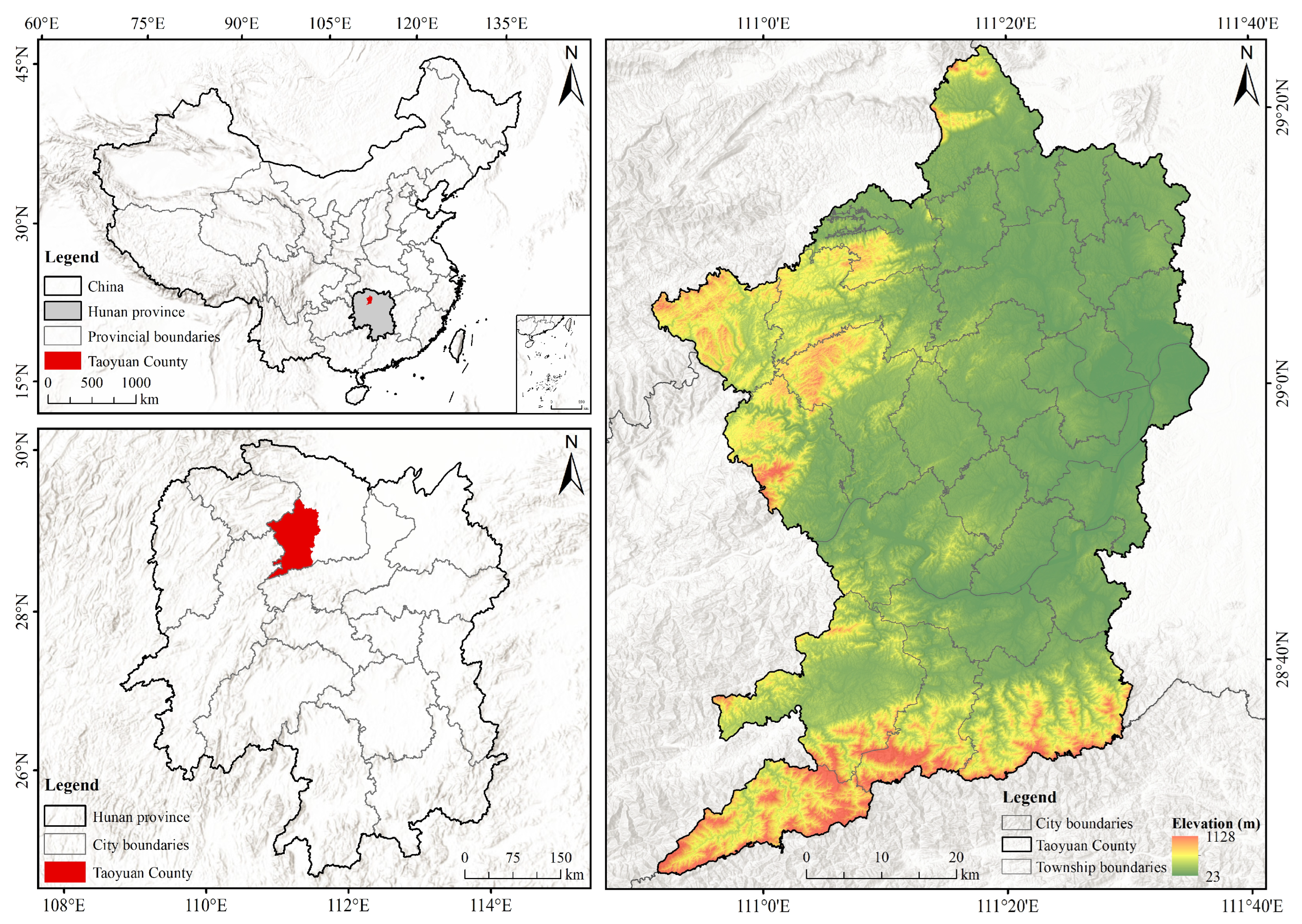
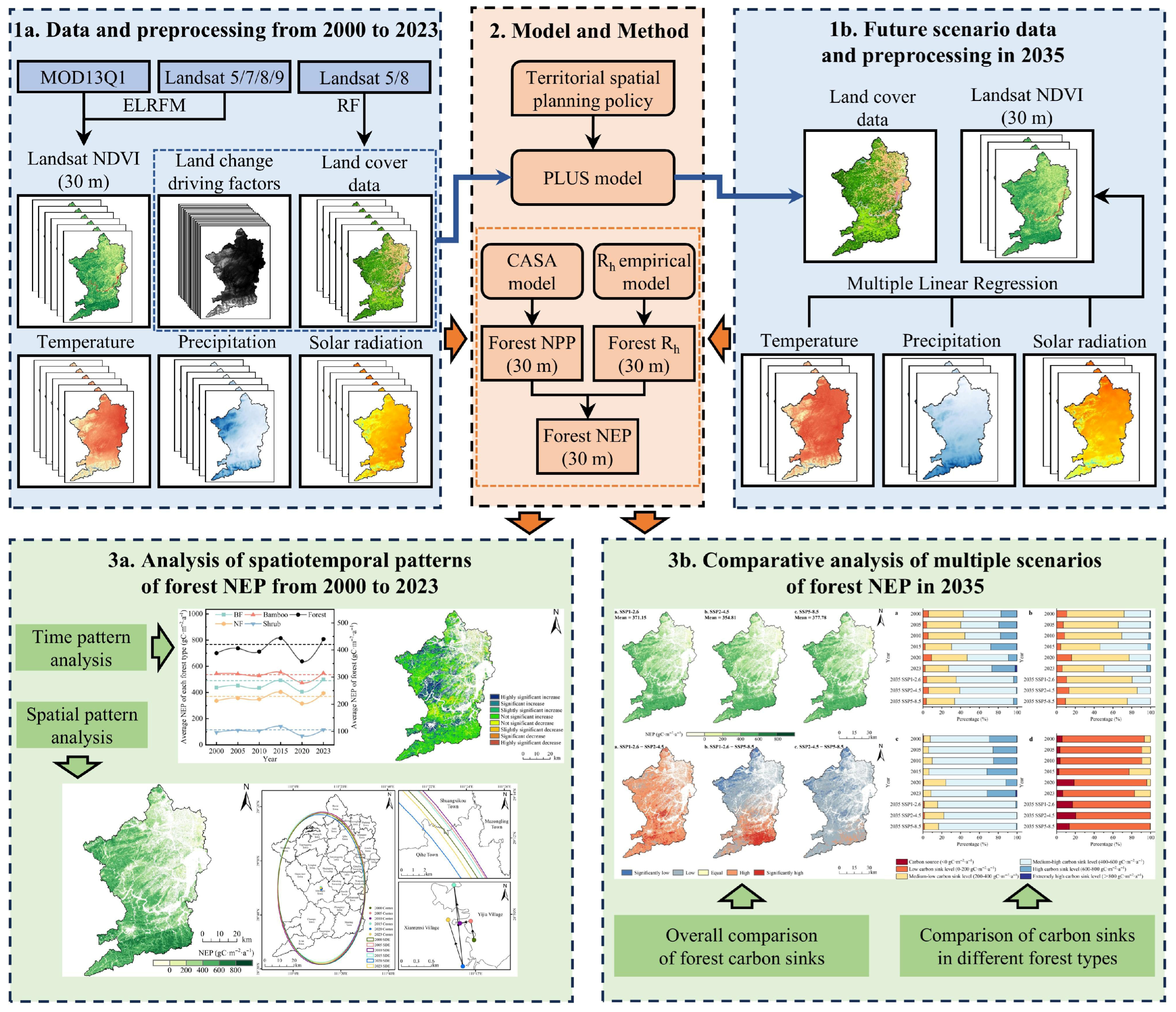
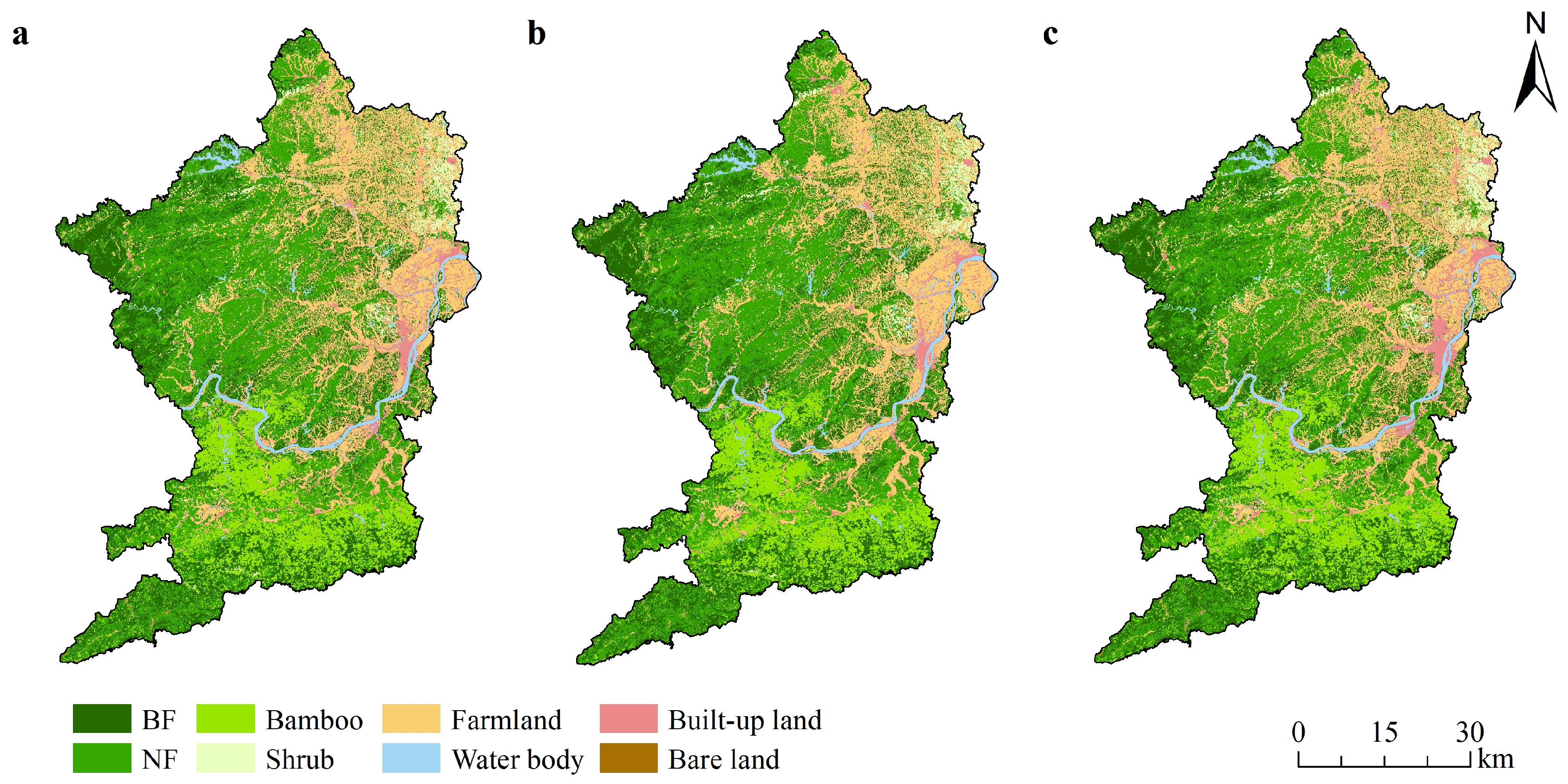
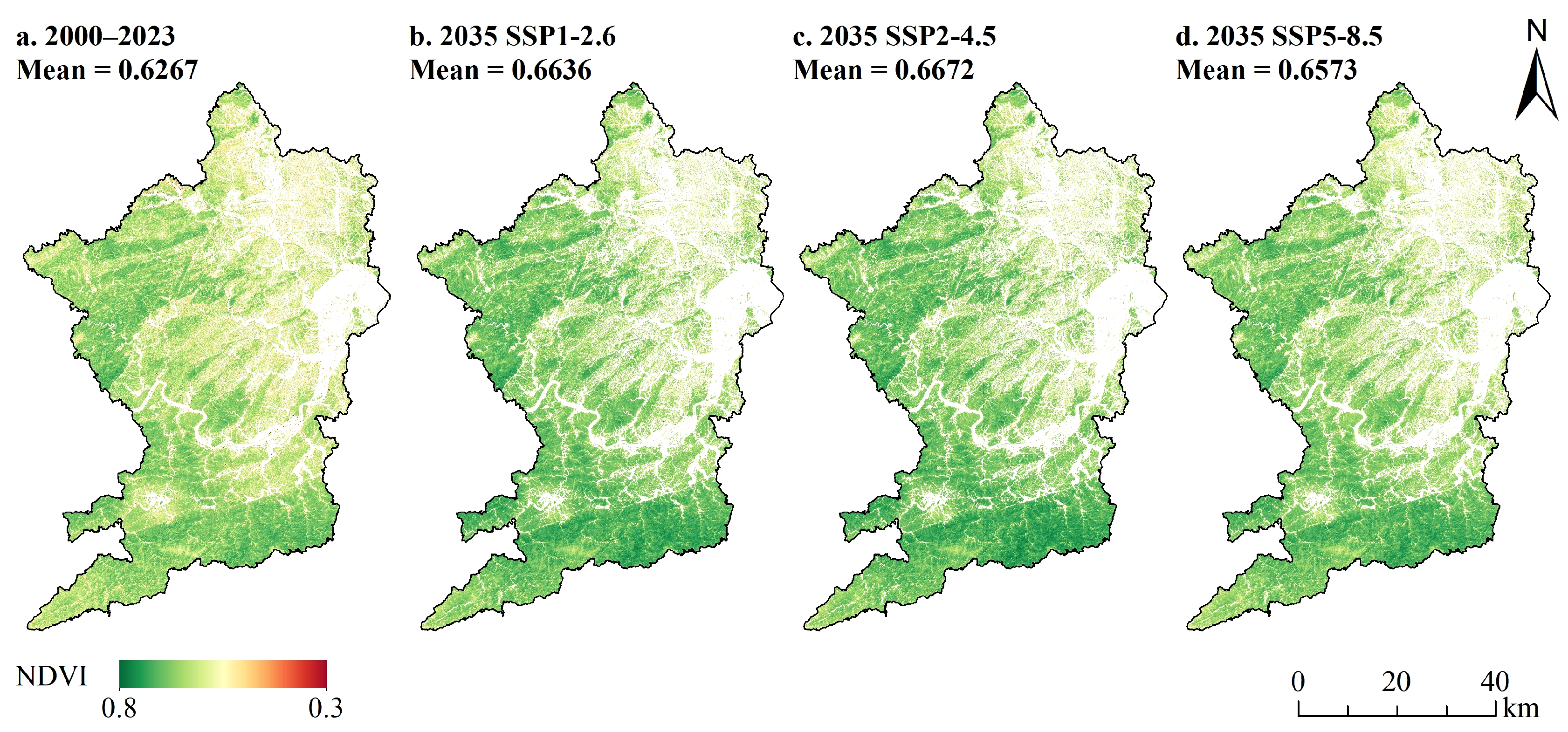
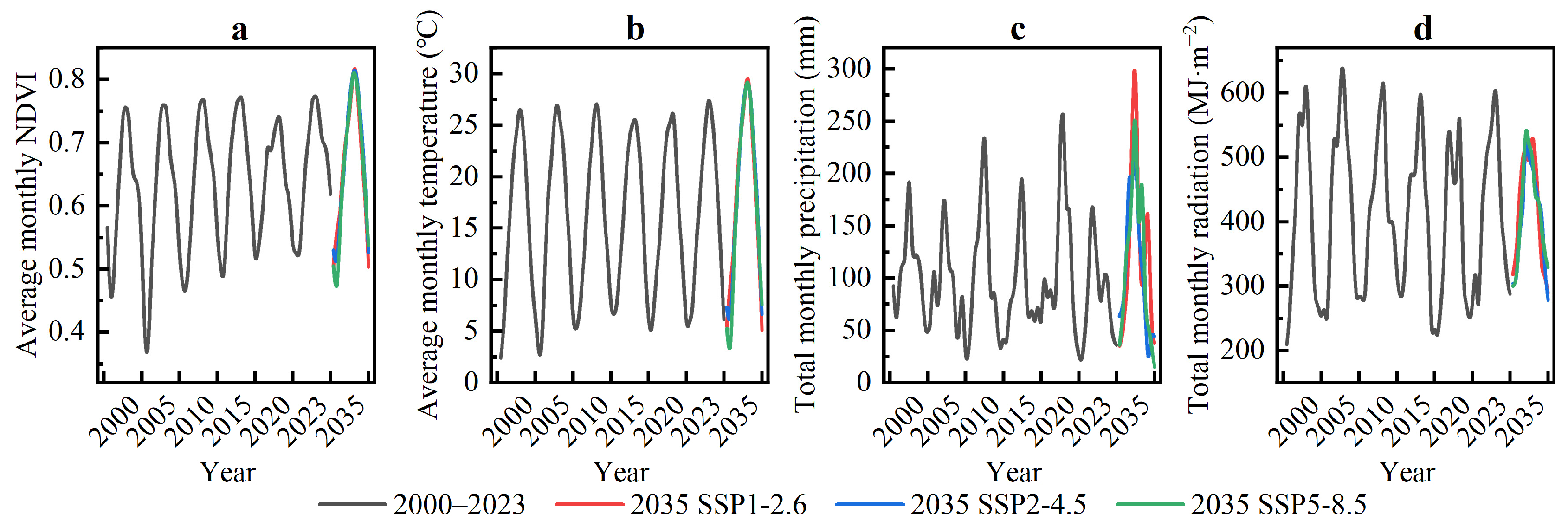
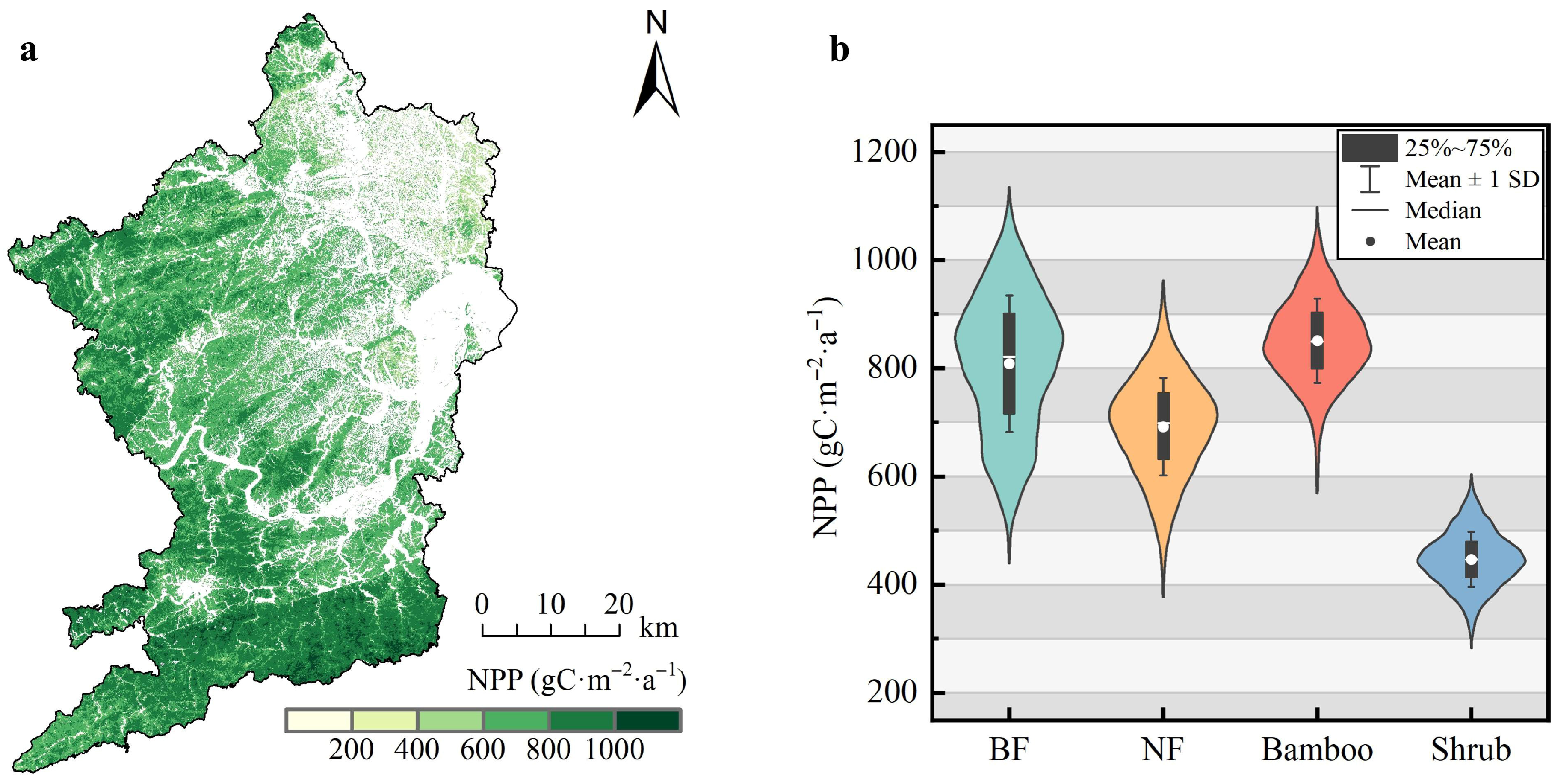
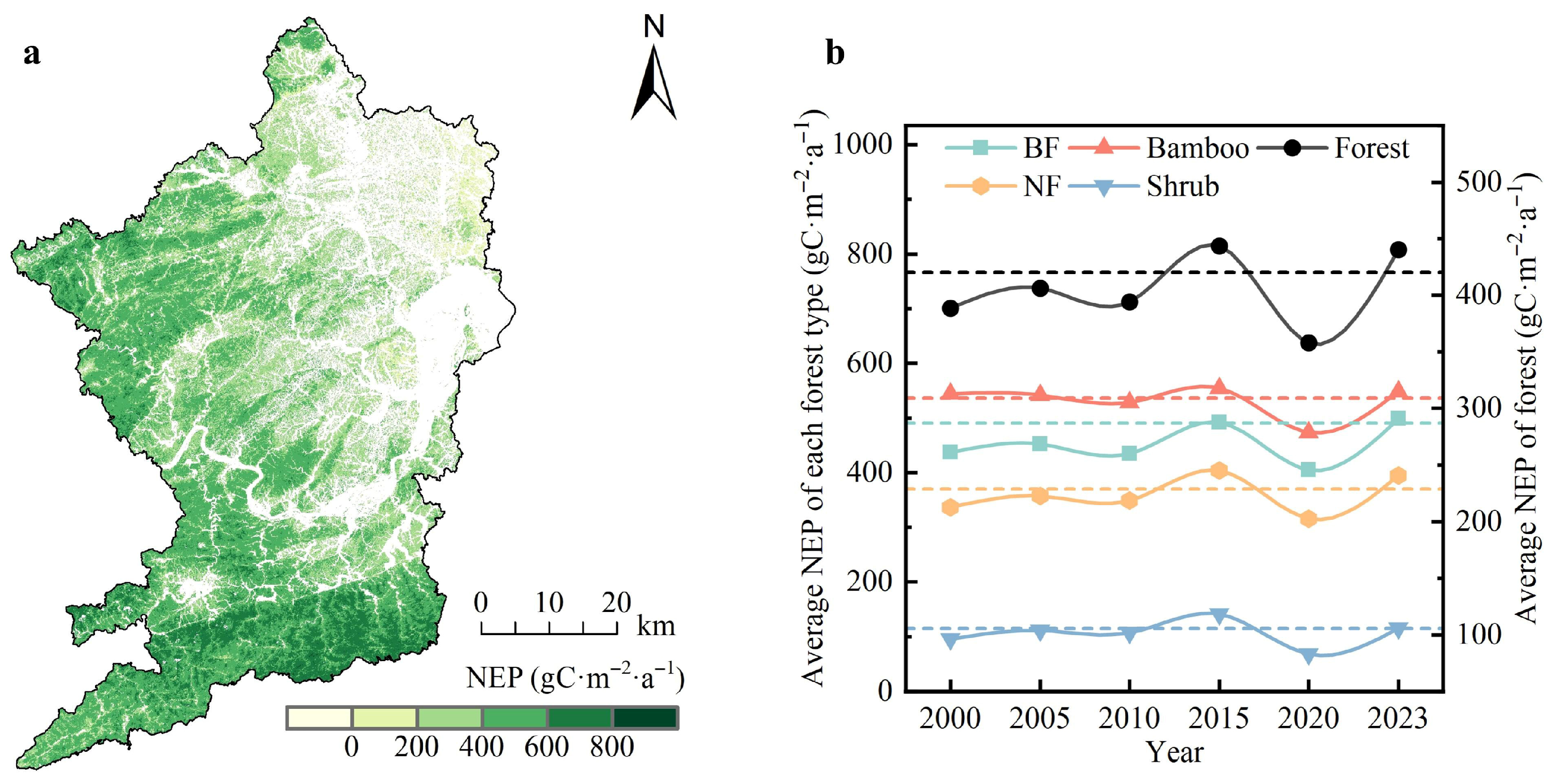
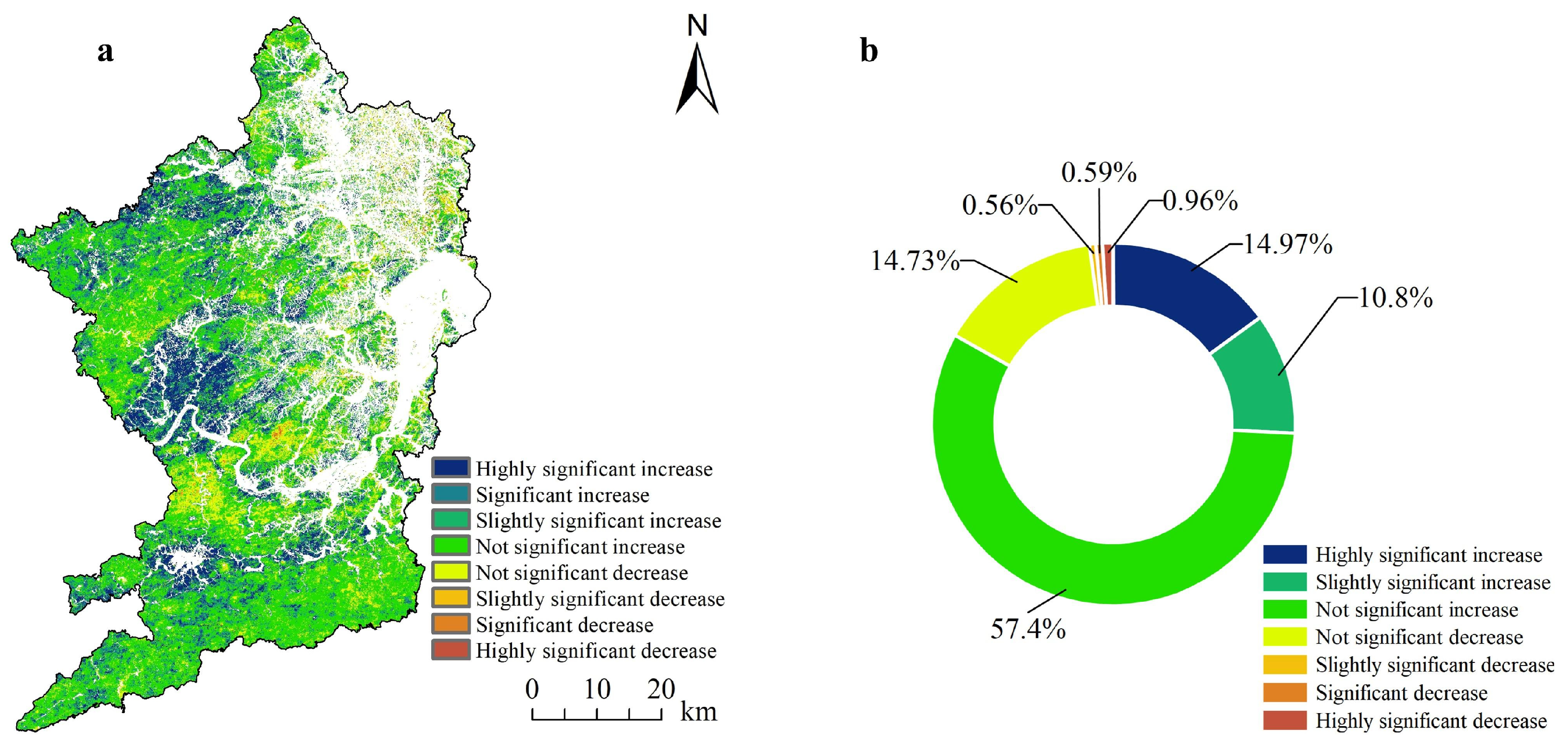


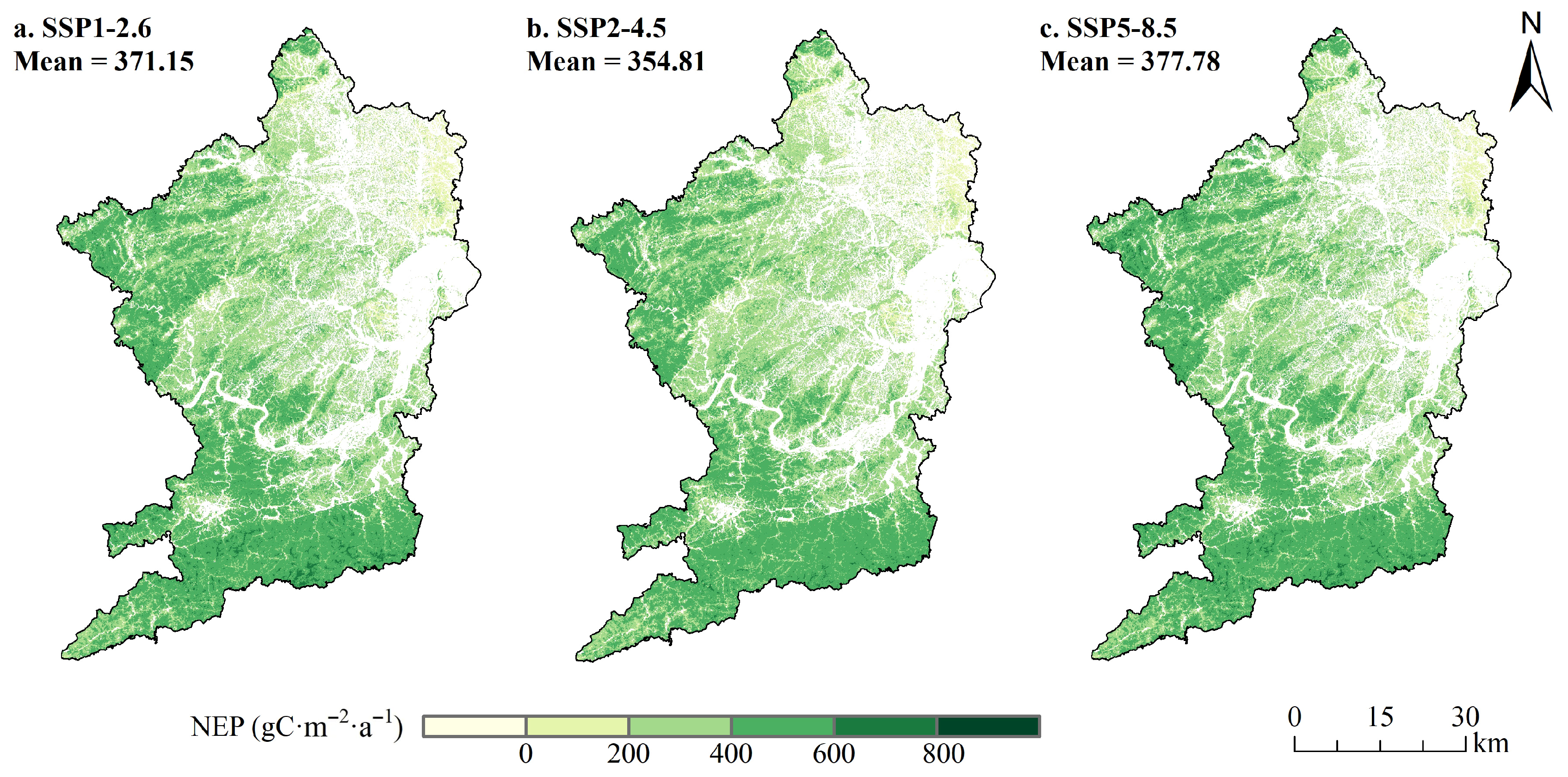

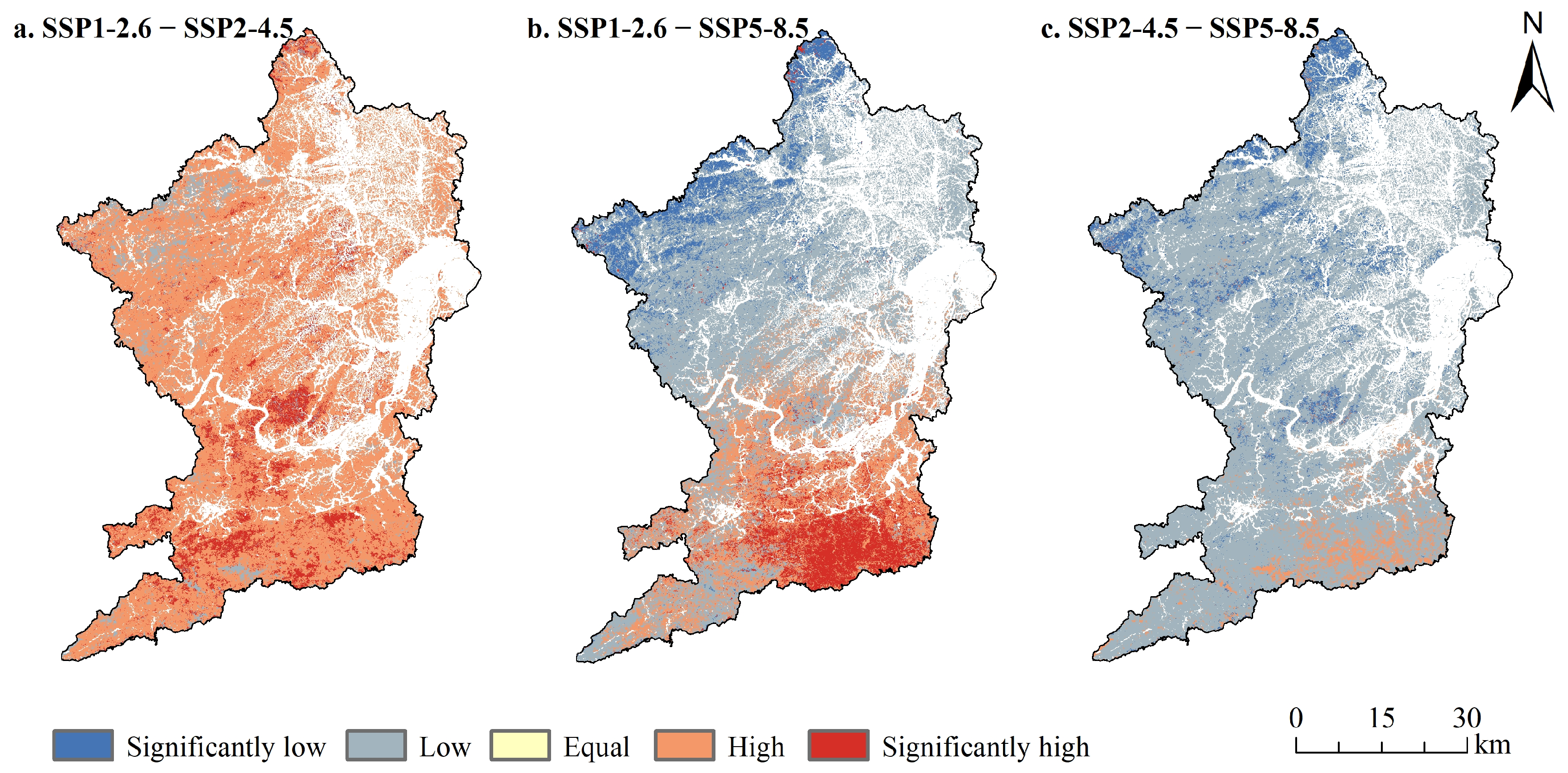
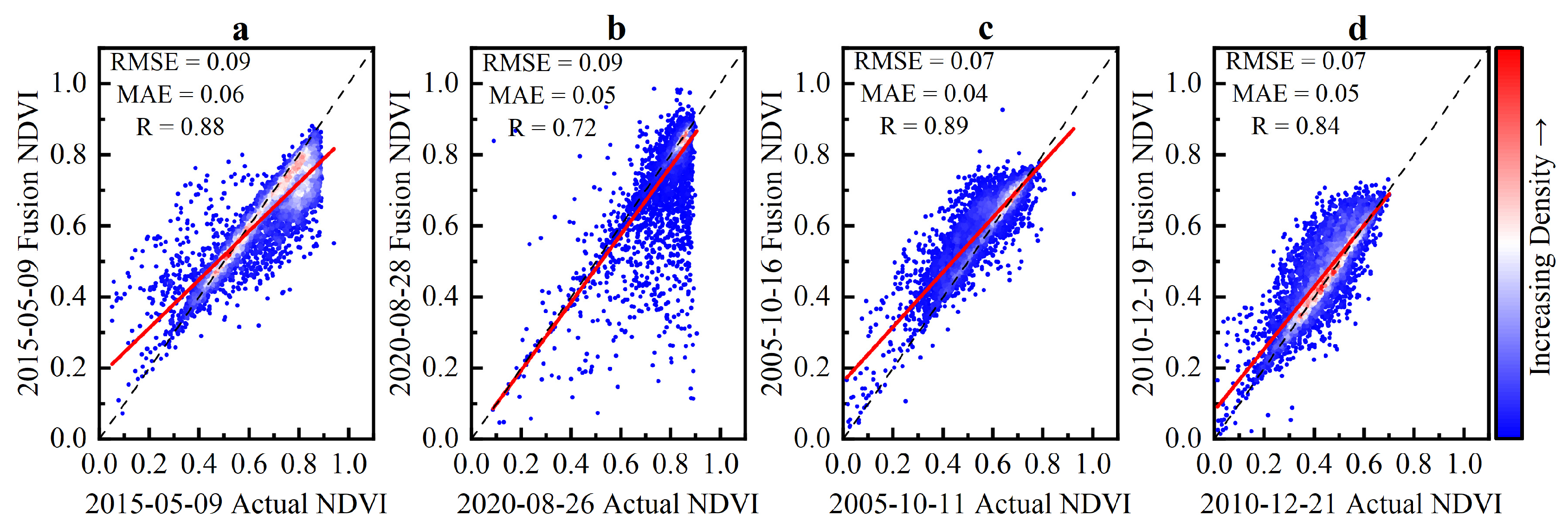

| Data Type | Name | Resolution (m) | Source |
|---|---|---|---|
| Remote sensing | MOD13Q1 NDVI | 250 | https://earthengine.google.com/ |
| Landsat 5/7/8/9 | 30 | ||
| Meteorological | Average monthly temperature | 30 | Fine Resolution Mapping of Mountain Environment |
| Total monthly precipitation | 30 | ||
| Total monthly solar radiation | 30 | ||
| Topographic | Digital elevation model (DEM) | 30 | https://earthengine.google.com/ |
| Slope | 30 | Derived from DEM | |
| Aspect | 30 | ||
| Socio-economic | Population density | 1000 | https://landscan.ornl.gov/ |
| Gross domestic product per capita | 1000 | http://gisrs.cn/ | |
| Road data (railroads, expressways, national, provincial, and county roads) | / | https://www.webmap.cn/ | |
| Government office locations | / | https://www.openstreetmap.org/ | |
| Auxiliary | Taoyuan County administrative boundary | / | Taoyuan County Forestry Bureau |
| Taoyuan County 2023 comprehensive forest, grassland, and wetland monitoring data | / | ||
| Taoyuan County territorial spatial planning policy data | / |
| 2000 | 2023 | ||||||||
|---|---|---|---|---|---|---|---|---|---|
| BF | NF | Bamboo | Shrub | Farmland | Water Body | Built-Up Land | Bare Land | Total | |
| BF | 768.67 | 115.08 | 28.16 | 15.41 | 61.79 | 2.85 | 16.29 | 0.63 | 1008.86 |
| NF | 160.25 | 1286.25 | 54.21 | 26.09 | 49.96 | 2.42 | 20.61 | 3.16 | 1602.95 |
| Bamboo | 25.10 | 17.05 | 406.83 | 0.44 | 0.09 | 0.18 | 0.49 | 0.09 | 450.27 |
| Shrub | 9.37 | 12.69 | 1.26 | 88.09 | 6.55 | 0.05 | 2.49 | 0.83 | 121.32 |
| Farmland | 60.92 | 23.63 | 0.79 | 12.15 | 804.43 | 5.21 | 99.69 | 1.23 | 1008.06 |
| Water body | 1.45 | 2.50 | 0.27 | 0.06 | 1.84 | 103.86 | 9.32 | 0.31 | 119.60 |
| Built-up land | 1.99 | 3.71 | 0.46 | 0.63 | 19.51 | 4.64 | 88.80 | 0.50 | 120.24 |
| Bare land | 0.90 | 2.11 | 0.09 | 1.11 | 2.07 | 0.03 | 0.69 | 0.50 | 7.49 |
| Total | 1028.64 | 1463.03 | 492.07 | 143.97 | 946.23 | 119.24 | 238.37 | 7.25 | 4438.79 |
| Forest Type | Year | Difference | Contribution of Area Changes to Total NEP | |
|---|---|---|---|---|
| 2000 | 2023 | |||
| BF | 44.08 | 51.29 | 7.21 | 0.97 |
| NF | 53.99 | 57.80 | 3.81 | −5.18 |
| Bamboo | 24.52 | 27.01 | 2.49 | 2.24 |
| Shrub | 1.16 | 1.66 | 0.50 | 0.26 |
| Year | 2000 | 2005 | 2010 | 2015 | 2020 | 2023 | 2035 |
|---|---|---|---|---|---|---|---|
| OA (%) | 81.61 | 81.54 | 80.92 | 84.29 | 86.46 | 83.89 | 80.83 |
| Kappa | 0.77 | 0.76 | 0.76 | 0.80 | 0.84 | 0.79 | 0.75 |
| Month | 1 | 2 | 3 | 4 | 5 | 6 | 7 | 8 | 9 | 10 | 11 | 12 |
|---|---|---|---|---|---|---|---|---|---|---|---|---|
| RMSE | 0.05 | 0.06 | 0.04 | 0.06 | 0.06 | 0.05 | 0.04 | 0.03 | 0.05 | 0.04 | 0.08 | 0.11 |
| MAE | 0.04 | 0.05 | 0.03 | 0.05 | 0.05 | 0.04 | 0.03 | 0.03 | 0.04 | 0.03 | 0.07 | 0.09 |
| R | 0.93 | 0.88 | 0.92 | 0.91 | 0.86 | 0.94 | 0.93 | 0.95 | 0.95 | 0.95 | 0.96 | 0.92 |
| Study Area | Time Scale | Average NPP (gC·m−2·a−1) | Bibliography |
|---|---|---|---|
| Taoyuan County | 2000–2023 | 679–768 | This study |
| Dongting Lake Wetland | 2000–2019 | 789 | [42] |
| Dongting Lake Basin | 2000–2019 | 700 | [43] |
| Chinese fir in Hunan Province | 1999–2014 | 715–764 | [44] |
| Wuling Mountain area of Hunan Province | 2000–2020 | 780–1400 | [45] |
| Yangtze River Basin | 2000–2020 | 552–839 | [46] |
| Yangtze River Basin | 2000–2020 | 594–786 | [47] |
Disclaimer/Publisher’s Note: The statements, opinions and data contained in all publications are solely those of the individual author(s) and contributor(s) and not of MDPI and/or the editor(s). MDPI and/or the editor(s) disclaim responsibility for any injury to people or property resulting from any ideas, methods, instructions or products referred to in the content. |
© 2025 by the authors. Licensee MDPI, Basel, Switzerland. This article is an open access article distributed under the terms and conditions of the Creative Commons Attribution (CC BY) license (https://creativecommons.org/licenses/by/4.0/).
Share and Cite
Lei, J.; Chen, C.; She, J.; Xu, Y. Spatiotemporal Dynamics and Future Climate Change Response of Forest Carbon Sinks in an Ecologically Oriented County. Sustainability 2025, 17, 6552. https://doi.org/10.3390/su17146552
Lei J, Chen C, She J, Xu Y. Spatiotemporal Dynamics and Future Climate Change Response of Forest Carbon Sinks in an Ecologically Oriented County. Sustainability. 2025; 17(14):6552. https://doi.org/10.3390/su17146552
Chicago/Turabian StyleLei, Jiale, Caihong Chen, Jiyun She, and Ye Xu. 2025. "Spatiotemporal Dynamics and Future Climate Change Response of Forest Carbon Sinks in an Ecologically Oriented County" Sustainability 17, no. 14: 6552. https://doi.org/10.3390/su17146552
APA StyleLei, J., Chen, C., She, J., & Xu, Y. (2025). Spatiotemporal Dynamics and Future Climate Change Response of Forest Carbon Sinks in an Ecologically Oriented County. Sustainability, 17(14), 6552. https://doi.org/10.3390/su17146552






